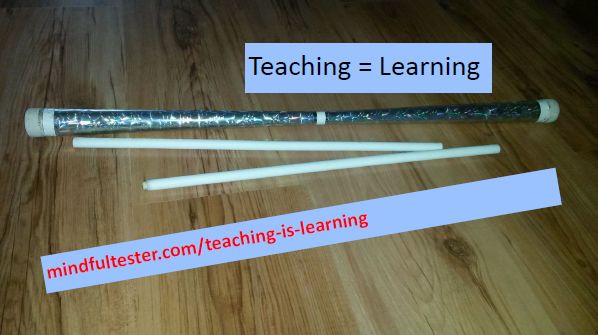- In the first half of this year, I wrote a serie of blog posts about accessibility. Is it possible to integrate it into Agile development? I did a thought experiment with Planning Poker.
- There is a lot of talk about using multiple ways to identify yourself. For certain services is the use of multi factor authentication needed to prevent problems. It is not about technology, but about process.
- In the spring I went with my family to an in person juggling convention. My kids enjoyed the juggling. Not bad for a dad for showing instead of teaching.
- After a lot of performances, I did some acts for blind and visually impaired people. Body language and sizes are difficult to show to this audience. I really put a lot of effort to tell how things look like. How big is a duck, if I cannot pass a bird around?
- As a free time juggler, I could not resist to give some lessons about juggling to blind and visually impaired people. This took me some effort to adjust it to their capabilities. I focused on feeling.For the interested people: I did contact juggling with balls, plate handling, and tricks with rings, pois, or devilstick.
- I also gave some workshops in balloon modelling to blind and visually impaired people.For me, balloon modelling is twisting and folding balloons into a nice object. The first time I showed a white dog above a white table. This was a bad contrast for some visually impaired attendees.
- I learned braille.
- In September I got the “Gives back” badge on the Club of Ministry of Testing. I gave more than 100 likes to other posts and got more than 100 likes on my posts. At the moment of blogging, I am one of the 32 people who got this badge.
- This year I took piano lessons in piano. The focus was on improvisation.
- In 2016 I wrote a blog post about a privacy issue on LinkedIn. 6 years later I discovered that this problem was solved.
- The hardest lesson I learned was to give people the help they asked for. In the past, I gave too much information.Of course, there is a chance that these 2 facts are unrelated.
- The last months, I started to micro blog again. Once in a few days I extended a blog post with a few lines. This keeps me blogging.
- At the end of the year, I published a blog post about speaking on tech conferences. Looking at my own experiences, I noticed some specific patterns.
- A day before Christmas, the Dutch version of “Condensed Agile Testing” by Lias Crispin and Janet Gregory became available. I translated 1 chapter. I am the Chinese looking guy, who made one of the contributions or bijdragen in Dutch.
Category Archives: Juggling
My Old Love
When My Old Love came to the Netherlands, I just wanted to go. Months in advance I had been notified, that Almere was the place to be. I know that this place is lying about 3 meters below sea level. I live more than 6 meters below sea level. So no problems with the change of level.
As I was writing, I wanted to look at My Old Love. My wife was all business. I had to ask her, if I wanted to go.
I got her approval.
Of course she would accompany me and the kids were also going with us (for good measures). So we were going to My Old Love, the European Juggling Convention. This yearly gathering of jugglers attracted more than 5000 visitors with interest in juggling, the art of throwing and catching things.
Finally
Stocked with juggling props we made our way to the EJC, European Juggling Convention, 2016. After parking the car we had to walk to the convention site and buy some tickets. Then my wife wanted to have a look at the whole site. I just wanted to juggle.
After more than fifteen minutes we finally sat down. I started to change clothes.
“What are you going to do?” my wife informed a bit concerned.
“I gonna juggle.”
Peer meeting as a service
Decades ago I lived in Delft with my juggling book. I was still making progress, but it was difficult. I needed space. A place, where I could juggle without the concern of breaking stuff.
To my surprise there was a weekly juggler meetup in my very little town. I contacted the organiser and became a member. The costs were low: a small contribution for the gym rent and I got free advice for juggling. Within a few years I became the meetup host.
Mike and I were the key holders. It was our task to open and close the gym. Soon things changed: music, a break with coffee and tea & a good atmosphere. This was a place to learn. It was a safe place to juggle. No hecklers included!
As you might have noticed in the blog name, my profession is tester. I test information systems. It was for me a logical step to become a board member of TestNet, the Dutch Special interest Group in Software Testing
For me it was not an honorary job. It was about providing a place to meet other peers. To exchange ideas and learn about software testing.
Let’s go back to My Old Love in Almere.
After the lunch I switched gyms. I wanted to meet other devilstickers.
Usually I give devilstick workshops on juggling conventions, but a last minute workshop would go unnoticed. I already spotted the workshop schedule though.
So I made contact in another way: find other devilsticking jugglers, devilstick, and exchange tricks. I found a small group, who swapped tricks. I showed some tricks and learned some tricks. Thanks Philippe for your patience and teaching me a new trick.
Back home I realised, that the European Juggling Convention had not changed. People juggling hula-hoops and kendamas were welcome. It still is a safe place to learn and practice.
Teaching = Learning
This week I sent 2 proposals for the Spring Event to TestNet, the Dutch Special Interest Group in Software Testing. One was for a presentation for 3 quarters of an hour, the other one for a workshop of 1 and a 1/2 hour. The process of writing proposals was time consuming and intense. My proposals will be rated and then ranked against the other proposals. Finally I will be notified, whether I have a speaker slot.
In 1992 I went to my first Dutch Juggling Convention. I was thrilled; I would be performing in the Public Show. It had taken me months to acquire the Blow Off Your Socks level of juggling. (I still dropped my juggling prop though.) The first part of the convention was a long warming up for my act.
On the first day I walked in the gym. I noticed a few people juggling, but a big white paper sheet drew my attention. It was a table. On one side time slots were mentioned, on the other workshop areas. 2 or 3 workshops had been filled in. A marker was hanging on a string.
I am still amused, how simple it is to book a workshop for myself on a juggling convention. No rating, no ranking. Just write down my name, juggling prop, and level. Or one name and two nouns. (The only exception I experienced is an International Juggling Association convention, but that is another story.)
There are many possible reasons, why I signed up to give a workshop. I only wanted to share knowledge about juggling. My favourite juggling prop is the devilstick. Wouldn’t it be great, if there were more good jugglers with a devilstick? So this workshop was not planned. A coincidence to happen.
If there is a huge juggling convention which cannot be ignored by a mainstream juggler, then it is the European one. My first European Juggling Convention was in Leeds. This time I came fully prepared. I had rehearsed two workshops for devilsticking in English, which definitely differs from my native language Dutch. The schedule of each workshop I had written down and memorised. And the tricks and combinations were still evolving during my preparations. The most difficult part was to locate the workshop schedule. You still remember that big white thing on the wall attached to a marker. I had planned two workshops, but gave a total of 3 workshops. Good response can be a nudge in the right direction.
Looking back I notice exciting patterns:
- Determine the biggest step people can take and still follow me.
[Blank faces.] - Discover and share new tricks and combinations, because attendees love them.
“Did you write a book?”
The most important thing I learned was to observe the attendees. A struggle with the devilstick triggered the reaction: I had either been unclear or combined too many movements. So their struggle became my struggle. By dissecting my juggling tricks for my workshop pupils I learned more than I imagined. I determined the elementary movements to make more combinations.
Once a young woman was impressed by my flurry of movements of the devilstick. Then a man remarked dryly: “He is just combining a few little tricks.”
Let’s go back to testing. It is my way to earn my living after all. In one consultancy company I had to earn my place as a teacher or workshop leader. I spoke with several colleagues about test courses. Yes, they were looking for new teachers. My pitch was: “I have more than 15 year of experience with giving workshops in juggling.”
In the meantime I started to teach mind mapping to my colleagues. The whole process of dissection repeated for me: why do you add branches clockwise? What is a fast way to make a mind map? A lot of questions, which bothered the attendees. I learned to mind map according to the rules, but also using mind map programs working around their restrictions.
BTW I wrote this post using a mind map program while commuting. I moved and added branches to make this a compelling story. Hopefully.
My pitch became: “I have experience with teaching mind maps to colleagues in our company. These are my scores from their feedback.”
Once I had a funny insight to illustrate testing Virtual Reality with juggling. I had one brilliant test idea to start with. My colleagues were supportive and a Bit sceptic (with a capital B). To everyone’s surprise my proposal was accepted in 2008. The preparation gave me lots of energy and inspiration. What is a good test idea and why? Let me break it down for you and show it to you with Real Life juggling.
Then I noticed that there were more people willing to speak than available speaker slots in a test conference. As you might have guessed: I did not speak at many test conferences.
I started to miss the thoughts in my head breaking down my testing examples and improving them. So I began to experiment on my work, but that was not enough.
Why not start a blog and write about mind mapping, SFDIPOT, and 2 screens? Wouldn’t it be great, if there are more good testers? So this blog post was not planned. A coincidence to happen.

